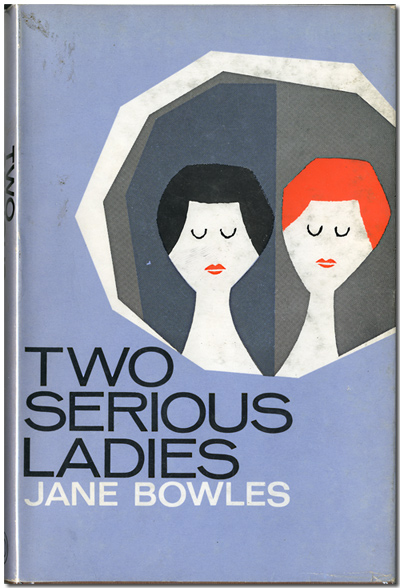A lot of the books I like are slim and dense, with sentences that, if you try to skip through them, will stall and stop you until they’ve exacted your patient, uninterrupted attention. They are slow reads in the most satisfying sense. When I find myself moving very quickly through a book, it is usually because the sentences do not matter so much – they are often flimsily built stilts that prop up the book’s preoccupation with plot and character.
Two Serious Ladies by Jane Bowles is neither slim nor dense. It is a fast read, due largely to the fact that it’s constructed almost entirely of dialogue. Scene to scene, from one eccentric individual to the next, the dialogue continues, yet never becomes tedious or awkward the way it can, and likely would, in someone else’s novel.
The dialogue is uncanny – it sounds both modern and antiquated, American and European, banal and hilarious – and it is the source of the book’s genius. It is exactly as Truman Capote says in his introduction to Bowles’s Collected Works in 1966: ‘Jane Bowles is an authoritative linguist; she speaks, with the greatest precision, French and Spanish and Arabic – perhaps this is why the dialogue of her stories sounds, or sounds to me, as though it has been translated into English from some delightful combination of other tongues.’

Yet one quickly realizes the smooth, swift-reading surface and high-society subjects of Two Serious Ladies are a deception. In a manner that portends the high modernism of a Diane Williams story, Miss Goering and Mrs. Copperfield embark on distinct, inscrutable journeys toward – what?
Miss Goering sells her luxurious family home to rent a squalid house on an obscure, inconvenient island, where she lives in disharmony with two hangers-on and pushes herself into increasingly alarming encounters with strangers. ‘It is not for fun that I am going,’ she says to herself on a night she takes a late train and ferry to the nearest town, ‘but because it is necessary to do so.’
Mrs Copperfield abandons her husband in Panama to take up residence in a shabby hotel with two women she’s just met. Drinking gin in her room, Mrs. Copperfield says (also to herself), ‘. . . how nice not to have to struggle too much for inner peace! I know that I shall enjoy certain moments of gaiety, willy-nilly. No one among my friends speaks any longer of character – and what interests us most, certainly, is finding out what we are like.’
The book’s strangeness is compounded by a conspicuous, glorious lack of description and explanation. Characters and surroundings are rendered artfully, minimally, bestowing the gift of mystery to the reader. I revere the authority with which Bowles has done this – never an easy task, but particularly remarkable considering she completed the novel while in her early twenties and published it in a year when other notable American novels included Ayn Rand’s The Fountainhead and Raymond Chandler’s The Lady in the Lake.
Two Serious Ladies ends unceremoniously and unresolved – to my mind the best sort of ending. I suppose this might upset some readers. I suppose the entire book might call into question what a novel should look like. This is not a small accomplishment.
Image © Gwen John







